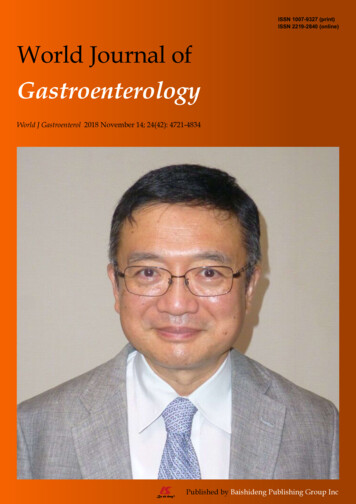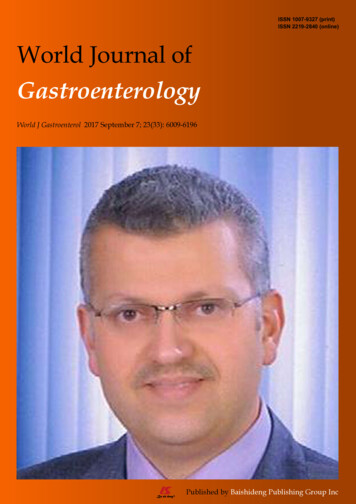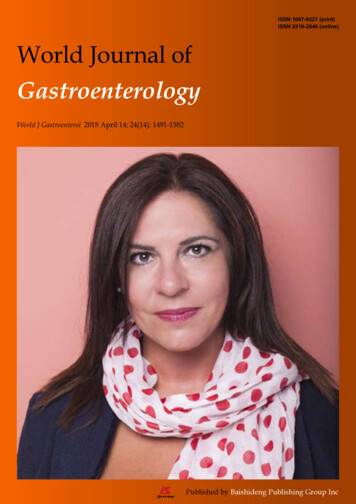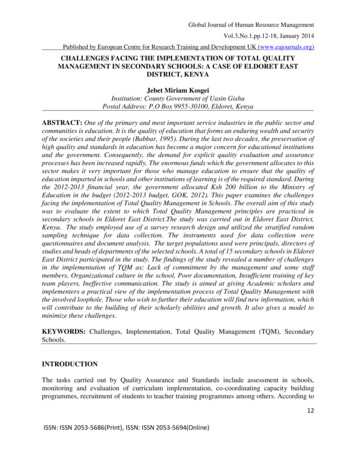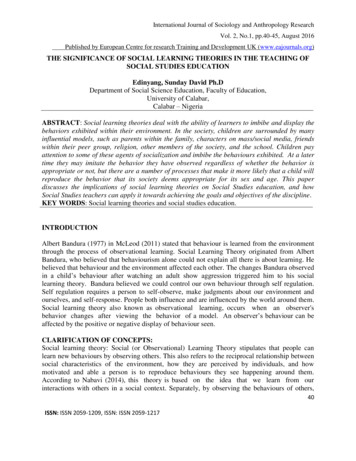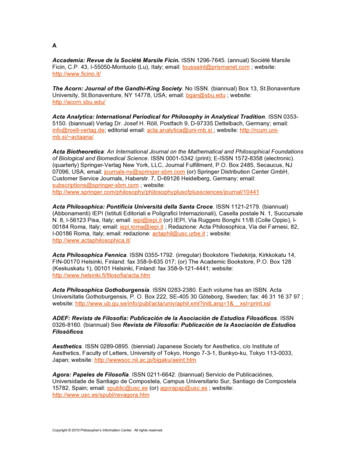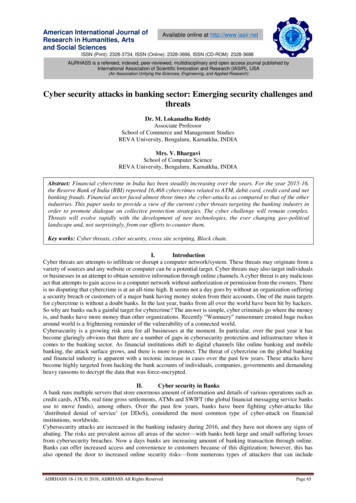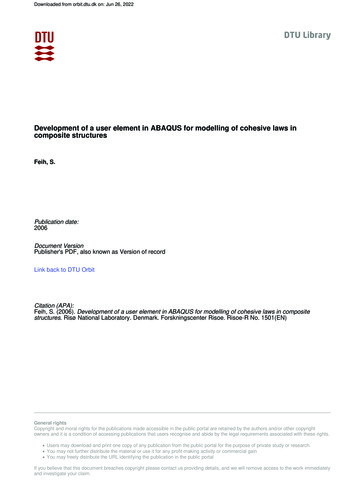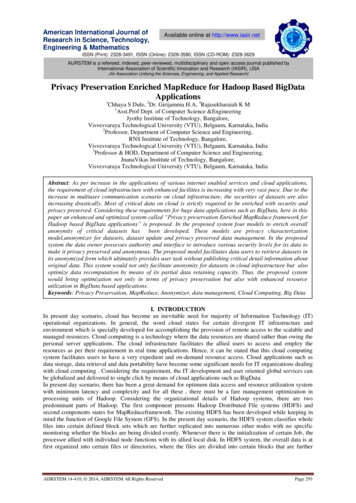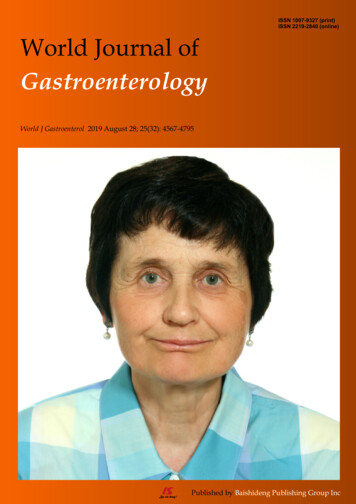
Transcription
ISSN 1007-9327 (print)ISSN 2219-2840 (online)World Journal ofGastroenterologyWorld J Gastroenterol 2019 August 28; 25(32): 4567-4795Published by Baishideng Publishing Group Inc
WJ GWorld Journal ofGastroenterologyContentsWeekly Volume 25 Number 32 August 28, 2019OPINION REVIEW4567New Era: Endoscopic treatment options in obesity–a paradigm shiftGlass J, Chaudhry A, Zeeshan MS, Ramzan ZREVIEW4580Chronic hepatitis delta: A state-of-the-art review and new therapiesGilman C, Heller T, Koh C4598Eosinophilic esophagitis: Current concepts in diagnosis and treatmentGómez-Aldana A, Jaramillo-Santos M, Delgado A, Jaramillo C, Lúquez-Mindiola A4614Locoregional treatments for hepatocellular carcinoma: Current evidence and future directionsInchingolo R, Posa A, Mariappan M, Spiliopoulos S4629Review of current diagnostic methods and advances in Helicobacter pylori diagnostics in the era of nextgeneration sequencingPohl D, Keller PM, Bordier V, Wagner KMINIREVIEWS4661Exploring the hepatitis C virus genome using single molecule real-time sequencingTakeda H, Yamashita T, Ueda Y, Sekine A4673Surgical management of Zollinger-Ellison syndrome: Classical considerations and current controversiesShao QQ, Zhao BB, Dong LB, Cao HT, Wang WB4682Positron-emission tomography for hepatocellular carcinoma: Current status and future prospectsLu RC, She B, Gao WT, Ji YH, Xu DD, Wang QS, Wang SBORIGINAL ARTICLEBasic Study4696Effect of mild moxibustion on intestinal microbiota and NLRP6 inflammasome signaling in rats with postinflammatory irritable bowel syndromeBao CH, Wang CY, Li GN, Yan YL, Wang D, Jin XM, Wu LY, Liu HR, Wang XM, Shi Z, Wu HG4715Growth arrest-specific gene 2 suppresses hepatocarcinogenesis by intervention of cell cycle and p53dependent apoptosisZhu RX, Cheng ASL, Chan HLY, Yang DY, Seto WKWJGhttps://www.wjgnet.comIAugust 28, 2019Volume 25Issue 32
World Journal of GastroenterologyContentsVolume 25 Number 32 August 28, 20194727Integrative analysis of the inverse expression patterns in pancreas development and cancer progressionZang HL, Huang GM, Ju HY, Tian XFRetrospective Study4739Prognostic value of red blood cell distribution width for severe acute pancreatitisZhang FX, Li ZL, Zhang ZD, Ma XCObservational Study4749Impact of national Human Development Index on liver cancer outcomes: Transition from 2008 to 2018Shao SY, Hu QD, Wang M, Zhao XY, Wu WT, Huang JM, Liang TBProspective Study4764On-treatment monitoring of liver fibrosis with serum hepatitis B core-related antigen in chronic hepatitis BChang XJ, Sun C, Chen Y, Li XD, Yu ZJ, Dong Z, Bai WL, Wang XD, Li ZQ, Chen D, Du WJ, Liao H, Jiang QY, Sun LJ, Li YY,Zhang CH, Xu DP, Chen YP, Li Q, Yang YPSYSTEMATIC REVIEWS4779Liver cirrhosis and left ventricle diastolic dysfunction: Systematic reviewStundiene I, Sarnelyte J, Norkute A, Aidietiene S, Liakina V, Masalaite L, Valantinas JWJGhttps://www.wjgnet.comIIAugust 28, 2019Volume 25Issue 32
World Journal of GastroenterologyContentsVolume 25 Number 32 August 28, 2019ABOUT COVEREditorial board member of World Journal of Gastroenterology, TamaraVorobjova, DA, PhD, Academic Research, Department of Immunology,Institute of Biomedicine and Translational Medicine, University of Tartu,Tartu 51014, EstoniaAIMS AND SCOPEWorld Journal of Gastroenterology (World J Gastroenterol, WJG, print ISSN 10079327, online ISSN 2219-2840, DOI: 10.3748) is a peer-reviewed open accessjournal. The WJG Editorial Board consists of 701 experts in gastroenterologyand hepatology from 58 countries.The primary task of WJG is to rapidly publish high-quality originalarticles, reviews, and commentaries in the fields of gastroenterology,hepatology, gastrointestinal endoscopy, gastrointestinal surgery,hepatobiliary surgery, gastrointestinal oncology, gastrointestinal radiationoncology, etc. The WJG is dedicated to become an influential andprestigious journal in gastroenterology and hepatology, to promote thedevelopment of above disciplines, and to improve the diagnostic andtherapeutic skill and expertise of clinicians.INDEXING/ABSTRACTINGThe WJG is now indexed in Current Contents /Clinical Medicine, Science CitationIndex Expanded (also known as SciSearch ), Journal Citation Reports , IndexMedicus, MEDLINE, PubMed, PubMed Central, and Scopus. The 2019 edition ofJournal Citation Report cites the 2018 impact factor for WJG as 3.411 (5-year impactfactor: 3.579), ranking WJG as 35th among 84 journals in gastroenterology andhepatology (quartile in category Q2). CiteScore (2018): 3.43.RESPONSIBLE EDITORS FORTHIS ISSUEResponsible Electronic Editor: Yan-Liang ZhangProofing Production Department Director: Yun-Xiaojian WuNAME OF JOURNALCOPYRIGHTWorld Journal of Gastroenterology 2019 Baishideng Publishing Group IncISSNINSTRUCTIONS TO AUTHORSISSN 1007-9327 (print) ISSN 2219-2840 CH DATEGUIDELINES FOR ETHICS DOCUMENTSOctober 1, YGUIDELINES FOR NON-NATIVE SPEAKERS OF 0EDITORS-IN-CHIEFPUBLICATION MISCONDUCTSubrata Ghosh, Andrzej S TORIAL BOARD MEMBERSARTICLE PROCESSING IAL OFFICESTEPS FOR SUBMITTING MANUSCRIPTSZe-Mao Gong, ICATION DATEONLINE SUBMISSIONAugust 28, 2019https://www.f6publishing.com 2019 Baishideng Publishing Group Inc. All rights reserved. 7041 Koll Center Parkway, Suite 160, Pleasanton, CA 94566, USAE-mail: bpgoffice@wjgnet.com August 28, 2019Volume 25Issue 32
World Journal ofGastroenterologyWJ GSubmit a Manuscript: https://www.f6publishing.comWorld J Gastroenterol 2019 August 28; 25(32): 4779-4795DOI: 10.3748/wjg.v25.i32.4779ISSN 1007-9327 (print) ISSN 2219-2840 (online)SYSTEMATIC REVIEWSLiver cirrhosis and left ventricle diastolic dysfunction: SystematicreviewIeva Stundiene, Julija Sarnelyte, Ausma Norkute, Sigita Aidietiene, Valentina Liakina, Laura Masalaite,Jonas ValantinasORCID number: Ieva Stundiene(0000-0002-2569-3638); JulijaSarnelyte (0000-0001-7578-3431);Ausma Norkute(0000-0002-9341-1049); SigitaAidietiene (0000-0002-8084-5657);Valentina Liakina(0000-0001-8685-1292); LauraMasalaite (0000-0002-0887-0866);Jonas Valantinas(0000-0003-4534-2293).Author contributions: Stundiene I,Sarnelyte J and Norkute Aseparately reviewed all of the titles,abstracts, full articles andperformed data extraction.Aidietiene S and Masalaite Lexcluded irrelevant articles.Liakina V reviewed extracted datafor accuracy. Stundiene I andSarnelyte J wrote the manuscriptwith support from Norkute A.Valantinas J, Liakina V andAidietiene S reviewed andapproved the final submittedmanuscript.Conflict-of-interest statement: Theauthors have no conflicts ofinterest.PRISMA 2009 Checklist statement:The authors have read the PRISMA2009 Checklist, and the manuscriptwas prepared and revisedaccording to the PRISMA 2009Checklist.Open-Access: This is an openaccess article that was selected byan in-house editor and fully peerreviewed by external reviewers. Itis distributed in accordance withthe Creative Commons AttributionNon Commercial (CC BY-NC 4.0)license, which permits others toWJGIeva Stundiene, Julija Sarnelyte, Valentina Liakina, Laura Masalaite, Jonas Valantinas, VilniusUniversity, Institute of Clinical Medicine, Clinic of Gastroenterology, Nephrourology andSurgery, Vilnius University, Vilnius LT-03101, LithuaniaAusma Norkute, Vilnius University, Institute of Clinical Medicine, Clinic of Internal diseases,Family medicine and Oncology, Vilnius University, Vilnius LT-03101, LithuaniaSigita Aidietiene, Vilnius University, Institute of Clinical Medicine, Clinic of Cardiology andAngiology, Vilnius University, Vilnius LT-03101, LithuaniaValentina Liakina, Vilnius Gediminas Technical University, Faculty of Fundamental Sciences,Department of Chemistry and Bioengineering, Vilnius LT-10223, LithuaniaCorresponding author: Julija Sarnelyte, MD, Academic Fellow, Clinic of Gastroenterology,Nephrourology and Surgery, Institute of Clinical Medicine, Vilnius University, UniversitetoStreet 3, Vilnius LT-03101, Lithuania. sarnelyte.julija@gmail.comTelephone: 370-62602666AbstractBACKGROUNDLiver cirrhosis is a chronic hepatic disease which is associated withcardiovascular abnormalities. Hyperdynamic circulation in liver cirrhosis causesfunctional and structural cardiac alterations. The prevalence of left ventriclediastolic dysfunction (LVDD) in cirrhotic patients ranges from 25.7% to as high as81.4% as reported in different studies. In several studies the severity of diastolicdysfunction (DD) correlated with a degree of liver failure and the rate ofdysfunction was higher in patients with decompensated cirrhosis compared withcompensated. Future directions of comprehensive assessment of cardiac functionin cirrhotic patients might provide a better prognosis for these patients.AIMTo clarify the correlation between the severity of liver cirrhosis and left ventriclediastolic dysfunction in the existing literature.METHODSThrough January and February of 2019 at Vilnius University we conducted asystematic review of the global existing literature on the prevalence of leftventricle diastolic dysfunction in patients with liver cirrhosis. We searched forarticles in PubMed, Medline and Web of science databases. Articles were selectedby using adequate inclusion and exclusion criteria. Our interest was the outcomehttps://www.wjgnet.com4779August 28, 2019Volume 25Issue 32
Stundiene I et al. Liver cirrhosis and LVDDdistribute, remix, adapt, buildupon this work non-commercially,and license their derivative workson different terms, provided theoriginal work is properly cited andthe use is non-commercial. of likely correlation between the severity of cirrhosis [evaluated by Child-Pughclasses, Model For End-Stage Liver Disease (MELD) scores] and left ventriclediastolic dysfunction [classified according to American Society ofEchocardiography (ASE) guidelines (2009, 2016)], as well as relative risk ofdysfunction in cirrhotic patients. Subgroup analyses were performed to evaluatethe ratio and grades of left ventricle diastolic dysfunction with respect to cirrhosisseverity.Manuscript source: InvitedRESULTSA total of 1149 articles and abstracts met the initial search criteria. Sixteen articleswhich met the predefined eligibility criteria were included in the final analysis.Overall, 1067 patients (out of them 723 men) with liver cirrhosis were evaluatedfor left ventricle diastolic dysfunction. In our systemic analysis we have foundthat 51.2% of cirrhotic patients had left ventricle diastolic dysfunction diagnosedand the grade 1 was the most prevalent (59.2%, P 0.001) among them, the grade3 had been rarely diagnosed - only 5.1%. The data about the prevalence ofdiastolic dysfunction in cirrhotic patients depending on Child-Pugh Classes wasavailable from 5 studies (365 patients overall) and only in 1 research diastolicdysfunction was found being associated with severity of liver cirrhosis (P 0.005). We established that diastolic dysfunction was diagnosed in 44.6% ofChild-Pugh A class patients, in 62% of Child B class and in 63.3% of Child Cpatients (P 0.028). The proportion of patients with higher diastolic dysfunctiongrades increases in more severe cirrhosis presentation (P 0.001). There was nodifference between mean MELD scores in patients with and without diastolicdysfunction and in different diastolic dysfunction groups. In all studies diastolicdysfunction was more frequent in patients with ascites.manuscriptReceived: April 22, 2019Peer-review started: April 22, 2019First decision: May 9, 2019Revised: June 10, 2019Accepted: July 19, 2019Article in press: July 19, 2019Published online: August 28, 2019P-Reviewer: Manenti A, Peng B,Tripathi D, Voiosu AM, Zapater PS-Editor: Ma RYL-Editor: AE-Editor: Zhang YLCONCLUSIONThis systemic analysis suggests that left ventricle diastolic dysfunction is anattribute of liver cirrhosis which has not received sufficient attention fromclinicians so far. Future suggestions of a comprehensive assessment of cardiacfunction in cirrhotic patients might provide a better prognosis for these patientsand give hint for better understanding of the left ventricle diastolic dysfunctionpathogenesis in liver cirrhosis.Key words: Liver cirrhosis; Left ventricle; Diastolic dysfunction; Correlation;Echocardiography; Systematic review The Author(s) 2019. Published by Baishideng Publishing Group Inc. All rights reserved.Core tip: In this systematic review we aimed to assess the association between leftventricle diastolic dysfunction and the severity of liver cirrhosis, evaluated by ChildPugh classes. The proportion of patients with higher diastolic dysfunction gradesincreases in more severe cirrhosis presentation (P 0.001). These results suggest thatleft ventricle diastolic dysfunction and its severity is an attribute of liver cirrhosis. Futuredirections of a comprehensive assessment of cardiac function in cirrhotic patients mightprovide a better prognosis to these patients and give hint for better understanding of theleft ventricle diastolic dysfunction pathogenesis in liver cirrhosis.Citation: Stundiene I, Sarnelyte J, Norkute A, Aidietiene S, Liakina V, Masalaite L,Valantinas J. Liver cirrhosis and left ventricle diastolic dysfunction: Systematic review.World J Gastroenterol 2019; 25(32): 4779-4795URL: .htmDOI: CTIONCirrhosis is a chronic hepatic disease that typically presents in individuals aged 50-60years [1,2] . This major health problem is one of the most common causes of deathworldwide and is associated with a wide range of cardiovascular gust 28, 2019Volume 25Issue 32
Stundiene I et al. Liver cirrhosis and LVDDPatients with cirrhosis typically demonstrate disturbance of circulatory system.Hyperdynamic circulation presented in patients with liver cirrhosis causes functionaland structural cardiac alterations[5-7]. These changes induce myocardial remodellingand left ventricle hypertrophy resulting in systolic and diastolic dysfunctions andcardiomyopathy[8-10].Cirrhotic cardiomyopathy is characterized by the following factors: impairedcontractile responsiveness to stress, diastolic dysfunction and electrophysiologicalabnormalities without overt cardiac disease[11,12]. Although this type of liver cirrhosiscomplication has been described since the 1960s, just recently it has been recognizednot only as a feature of alcoholic cardiotoxicity but as an ailment occurring in cirrhosisof any aetiology[13].The most common cardiac abnormality that occurs among cirrhotic patients is leftventricular diastolic dysfunction (LVDD) related to development of myocardialfibrosis, hypertrophy and subendothelial edema[5-7]. Diastolic dysfunction occurswhen the passive elastic traits of the myocardium are reduced due to the increasedmyocardial mass and changes in the extracellular collagen[14].According to different studies, the prevalence of LVDD in cirrhotic patients isranging from 25.7% to as high as 81.4%[15,16]. Evidence suggests that patients withcirrhosis display primarily LVDD with normal systolic function at rest [1]. Diastolicdysfunction may progress to systolic dysfunction, although this has not been directlyshown in cirrhotic patients[17-19]. In several studies severity of LVDD correlated withthe degree of liver failure [20-22] . Furthermore, the rate of LVDD was higher indecompensated cirrhosis compared with compensated cirrhosis[23]. On the contrary,several studies have not identified any association between severity of liver diseaseand LVDD[24-26]. Therefore an attentive analysis of already performed studies on LVDDcauses and prevalence in cirrhotic patients as well as LVDD complication influence onpatients’ quality of life and their survival is needed to develop appropriate treatmentstrategy. It is important to assess cardiac changes in especially those patients, who arewaiting for the liver transplantation, paracentesis or transjugular intrahepaticportosystemic shunt (TIPSS) implantation, because cardiovascular decompensationcan be the main cause of operative failure.The aim of our study was to conduct a systematic review of the existing literatureto collate all data about the cause, diagnosis, prognosis of LVDD in cirrhotic patientsand try to elucidate the association between severity of liver disease and LVDD withthe intention to propose measures for the therapy of cirrhotic patients with LVDD.MATERIALS AND METHODSSearch strategyAn electronic search of the global literature on the prevalence of left ventricle diastolicdysfunction in liver cirrhosis was performed. Articles available in PubMed, Medlineand Web of Science databases were reviewed in January and February 2019. Theperiod of publications collected was 1969-2019.The Medical Subject Heading (MeSH) database was used as a terminological searchfilter. The last search date was 7/3/2019. The main key phrases for searching thearticles were: “left ventricle diastolic dysfunction” and “liver cirrhosis“. These termswere connected together to narrow our search by using a Boolean operator AND. OurMeSH Major Topic was “Liver cirrhosis/*complications“ and the main MeSHSubheading was “left ventricle diastolic dysfunction/*etiology, diagnosis, treatment”.To describe diastolic dysfunction we used these terms: Left ventricle diastolicdysfunction, cirrhotic cardiomyopathy, diastolic function of left ventricle, ventriculardysfunction, left. The full terms used in PubMed search can be found in electronicsupplementary material.Eligibility criteriaStudies were considered eligible if they met the following criteria: (1) Articlespublished in English only; (2) Only patients with liver cirrhosis diagnosed by clinicalview, laboratory and imaging tests were included; (3) Severity of liver cirrhosis wasevaluated by using Model for End-Stage Liver Disease score, (MELD score) or/andChild-Pugh classification A/B/C and scores.; (4) Left ventricle diastolic function wasevaluated by tissue Doppler imaging method; and (5) Left ventricle diastolicdysfunction was defined and its grading (1, 2, 3) classified according to ASE 2009 or2016 guidelines[27,28].The exclusion criteria were: (1) Studies with children ( 18 years old); (2)Retrospective studies; (3) No proper definition of left ventricle diastolic dysfunctionaccording to ASE guidelines (2009, 2016); (4) No grading of left ventricle diastolicWJGhttps://www.wjgnet.com4781August 28, 2019Volume 25Issue 32
Stundiene I et al. Liver cirrhosis and LVDDdysfunction according to ASE guidelines (2009, 2016); (5) Only systolic functionevaluated; (6) Other causes of liver insufficiency, for example, toxic liver disease,septicaemia; (7) No severity of cirrhosis evaluated by using MELD score and ChildPugh classification; (8) Patients who had chronic heart disease, for example, valvularpathology, coronary heart disease, arrhythmias, as atrial fibrillation (Patients withchronic heart disease other than cirrhotic cardiomyopathy); (9) No humanparticipants in the study; (10) No full article available; and (11) Article not available inEnglish.Our interest was the correlation between the severity of cirrhosis and left ventriclediastolic dysfunction, relative risk of LVDD in liver cirrhosis group.Three investigators separately reviewed all the titles, abstracts and full articles.Reviewers excluded irrelevant articles. The disagreement on whether to include or notthe article was solved by other two investigators. Data extraction was performed bythree investigators and reviewed for accuracy by another investigator.Total number of patients, number of healthy controls, age, etiology of cirrhosis,Child-Pugh scores and classification A/B/C, MELD score, the presence of ascites,LVDD, the grading of diastolic dysfunction, the year of the LVDD guidelines used,influence of LVDD on survival of the patients with cirrhosis were recorded. Somestudies had missing data for Child-Pugh classification, MELD scores or did not have ahealthy controls group.The risk of bias for each study was evaluated by using ROBINS-I tool from theCochrane Method group at the study level[29]. All of the major domains were selected:confounding, selection of the participants, evaluation of LVDD and grading, missingdata, selection of the reported results and measurement of outcomes[29].Statistical analysisThis systematic review was prepared and revised according to the PRISMA 2009Checklist[30]. Statistical evaluation was performed with R version 3.5.3 (GNU Project).Studies meeting the inclusion criteria were tabulated. Statistically and clinicallyappropriate studies were combined to estimate the LVDD prevalence and LVDDgrades’ distribution in patients with respect to cirrhosis severity.To evaluate the overall distribution of LVDD grades in cirrhotic patients χ 2goodness-of-fit test was applied. Pearson’s χ2 was used for comparing the distributionof patients with and without LVDD in three Child-Pugh groups.For analysing of LVDD grades ratio in three Child-Pugh groups and LVDDprevalence in cirrhotics with and without ascites Pearson’s χ2 and Fisher exact testswere used. P value 0.05 was considered as statistically significant.RESULTSA total of 1149 articles and abstracts met the initial search criteria.Out of 1149 articles 91 were selected for full text review. As many as 16 articles thatmet the predefined eligibility criteria were included in the final analysis[15,16,21,22,24-26,31-39].The process of identification, screening and eligibility is described in Figure 1.Included studies and patients’ characteristics are shown in Table 1. Overall 1067patients (of which 723 were men) with liver cirrhosis were evaluated for LVDD. Outof 16 studies 9 had control group, altogether 318 control subjects included.The risk of bias for each study is demonstrated in Table 2.Diagnosis of LVDDAll patients and controls had echocardiography with tissue Doppler imagingperformed. Tested parameters of LVDD are shown in Table 3.The data about LVDD, its grades and guidelines used in every study is depicted inTable 4.In our systemic analysis we found 51.2% of cirrhotic patients had LVDD diagnosedand the grade 1 was the most prevalent (59.2%, P 0.001) among them. The grade 3had been rarely diagnosed - only in 5.1%.In most studies controls had no cardiac dysfunction but in two studies[35,25] 4.7%(overall 15 out of 318) controls were diagnosed with LVDD.Link between LVDD and Child-Pugh classification parametersIn our systemic analysis the data about LVDD prevalence in cirrhotic patientsdepending on Child-Pugh classes was available from 5 studies (365 patientsoverall)[16,24,25,32,34] and only Bhuin et al[16] found LVDD being associated with severity ofliver cirrhosis (P 0.005). Other four studies did not find any difference in the severityof LVDD among Child classes[24,25,32,34].After analysing this data we observed that LVDD was diagnosed in 44.6% (29) ofWJGhttps://www.wjgnet.com4782August 28, 2019Volume 25Issue 32
Stundiene I et al. Liver cirrhosis and LVDDFigure 1Figure 1 Final articles selection.Child-Pugh A class patients, in 62% (101) of Child B class and in 63.3% (81) of Child Cpatients (P 0.028).Only three studies reported how many patients with different LVDD grades werein different Child-Pugh classes[16,21,25]. Figure 2 shows that the proportion of patientswith higher LVDD grades increases in the presence of more severe cirrhosis.In Merli et al[37] study patients were divided in two groups: Child-Pugh A-B classesand Child-Pugh C class patients. In order not to lose the data reported in this studywe also divided all patients from other 5 studies into the same two groups andanalysed all patient data from 6 studies[16,24,25,32,34,37]. LVDD was found in 49.3% (149) ofpatients of Child - Pugh A B classes and in 59.7% (86) of Child - Pugh C class patients(P 0.051).The prevalence of different LVDD grades in grouped Child-Pugh classes is shownin Figure 3.The difference in means of Child-Pugh scores between LVDD grades was analysedin 5 studies [21,24,25,33,34,36] (Table 5). In two studies the considerable difference wasobserved. Ruız-del-Arbol identified the substantial difference (P 0.01) betweenmean Child-Pugh scores in LVDD grade 2 and LVDD grade 0 groups[21]. In Rimbas etal[36] study Child-Pugh scores were markedly higher in patients with liver cirrhosis ofLVDD grade 2 than in those with grades 1 and no LVDD.Link between LVDD and MELD scoresThe difference in means of MELD scores between LVDD groups and in patientswithout LVDD was estimated in 8 studies[21,24,32,33,34,36,38,39] (Table 6). Two studies foundthat patients from the grade 2 LVDD subgroup had a higher MELD score, comparedto patients with grade 1 LVDD and without LVDD (P 0.01 and P 0.005,respectively)[21,36]. The means of MELD scores did not markedly differ in patients withand without LVDD in remaining 6 studies[24,32,33,34,38,39].Survival and LVDDIn the study of Lee et al[32] the survival rate was substantially lower in patients withLVDD than in those without LVDD (31.1 mo vs 42.6 mo, P 0.01). Patients with aratio of early filling velocity to early diastolic mitral annular velocity (E/e’) 10(LVDD grade 2) had lower survival than the patients with E/e’ ratio 10.In Ruiz-Del-Albor study patients without LVDD had the longest and those withgrade 2 LVDD the shortest probability of survival [95% vs 39% (P 0.01), respectively][21]. The value of the E/e’ ratio with higher sensitivity and specificity topredict 12-mo survival was 10. Survival was significantly greater in E/e’ 10,compared to the E/e’ 10 group [91% and 29% (P 0.0001), respectively][21].On Kaplan-Meier analysis in Karagiannakis et al[33] study patients with LVDD hadWJGhttps://www.wjgnet.com4783August 28, 2019Volume 25Issue 32
Stundiene I et al. Liver cirrhosis and LVDDTable 1 Included studies and patients’ characteristicsAuthorStudytypeNumberGender Control,of cases,(male), n nnEtiology of cirrhosis, nVAOMeans1 Child-Pugh classification, nof ChildPughABCscores'Dadhichet al[31]Crosssectionalcasecontrolstudy40ND20261047.5 1.08 4pre-asciticgroup, 9.4 2.11asciticgroup22Lee etal[32]Cohortstudy7055016477ND1835Karagian Cohortnakis et studyal[33]45E330192246.43 1.92615311.5 4.2Alexopoulou 59.2 2.711283717 7Farouk et Crossal[15]sectionalstudy35221635ND61415NDBhuin etal[16]Descrip70tive study32070ND43828NDCesari etal[35]Caseseries1171064657608 2NDNDND12 5Ru ızdelArbol, etal[21]Crosssectional806703235138 2grade 0; 9 2 grade1; 10 2grade 2;12303815 6grade 0;16 5grade 1;21 6grade 2;Rimbaset al[36]Crosssectionalobservationalstudy463046192437 22316713 5Hammami etal[25]Crosssectionalstudy8042804238ND24362014.2 4.98Merli 13ND48261611.9 4.7Merli etal[26]Caseseries744426412112ND29261913 5Kazanko Crossv et al[38] sectionalobservationalstudy44272353277.1 2.22012812.3 4.9Nazar etal[22]100710414615with26LVDD 9 2; noLVDD 8 2.2393715 7Devauch Descrip40elle ettive studyal[39]3009247ND1391816Somaniet al[24]60483022308ND8262615.2 4.6withoutLVDD;14.6 ust 28, 201914Means1of MELDscores'ND14.1 5.9Volume 25Issue 32
Stundiene I et al. Liver cirrhosis and LVDD1Values are expressed as mean standard deviation. V: Viral; A: Alcoholic; O: Other; ND: No data.markedly worse prognosis compared to those without (P 0.013, log rank: 5.495).A multivariate analysis in the study of Alexopoulou et al[34] showed that age, MELDand plasma sodium but no LVDD were predictive of death. In three other studies nosubstantial difference in survival was found between patients with or withoutLVDD[24,36,37].Link between ascites and LVDDThe association of ascites and LVDD was assessed in 8 studies (Table 7)[21,22,26,31,35].Overall 604 patients were studied and in 56.9% of those with ascites LVDD wasdiagnosed (in 211 patients out of 371) while in 48.5% (113 out of 233) of patientswithout ascites LVDD presented, P 0.04451.Dadlich et al[31] showed that the majority of the cirrhotic patients with ascites (80%)had LVDD compared to those without ascites but the difference was not provedstatistically (P 0.09). Ruiz-del-Arbor et al[21] in their research showed that ascites wasmore frequent in LVDD grade 2 comparing with LVDD grade 1 (P 0.025) andnormal diastolic function (P 0.01). Alexopoulou et al[34] investigated that severeascites was more frequent in the group with LVDD (P 0.016). In 2013 Merli et al[26]noticed that LVDD was more prevalent in patients with ascites compared to thosewithout it (77% vs 56%; P 0.04).Link between LVDD and ageThe older age and the presence of LVDD was assessed in 10 studies (Table 8). LVDDwas associated with an older age in 4 studies[32-35]. On the contrary, 6 studies foundthat LVDD was not associated with an older age but there was no evidence of ageimpact on LVDD in all these studies[21,22,24,31,38,39].DISCUSSIONTo our knowledge this is the first systematic review which summarizes the articlesdemonstrating the association between the severity of liver cirrhosis and LVDD.Numerous studies have shown changes in the diastolic function in patients withliver cirrhosis. The prevalence of diastolic dysfunction in the articles analysed by oursystematic review ranged from 25.7% to 81.4%[15,16]. More than half of all patientsincluded in our review had some degree of diastolic dysfunction (51.2 %). As many as59.2% of all patients with LVDD was grade 1 dysfunction
4764 On-treatment monitoring of liver fibrosis with serum hepatitis B core-related antigen in chronic hepatitis B Chang XJ, Sun C, Chen Y, Li XD, Yu ZJ, Dong Z, Bai WL, Wang XD, Li ZQ, Chen D, Du WJ, Liao H, Jiang QY, Sun LJ, Li YY, . Medline and Web of science databases. Articles were selected by using adequate inclusion and exclusion .
